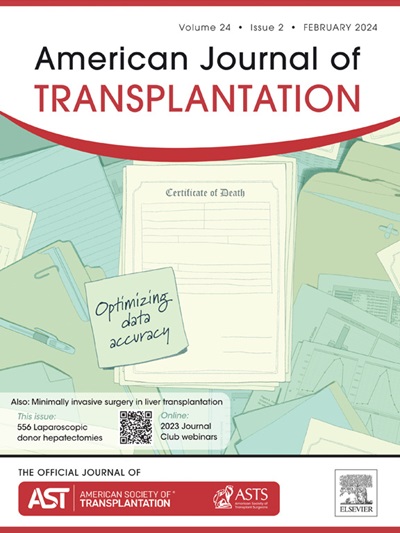Unraveling CD8+ T cell alloimmunity: Insights into the direct pathway of antigen recognition from modern experimental tools
IF 8.2
2区 医学
Q1 SURGERY
引用次数: 0
Abstract
Early experimental investigations of alloimmunity demonstrated that the T cell response against allogeneic antigens is robust and results from a high precursor frequency of responding clones. Seminal studies using cell culture-based methods led to an overall model in which CD8+ T cells can recognize self-peptide complexed to an allogeneic peptide major histocompatibility complex (MHC), termed the direct allogeneic antigen recognition pathway. Recently, 3 groups used modern experimental approaches, including MHC class I tetramers, to further investigate the nature of direct allogeneic antigen recognition by CD8+ T cells in mice and humans. In a model of liver-induced transplant tolerance, researchers showed that the MHC class I alloimmune CD8+ T cell response is peptide-dependent. Researchers elucidated the H-Ld QL9 allogeneic epitope and showed that reactive CD8+ T cells were peptide discriminating. Researchers also engineered artificial antigen-presenting cells to show that human alloreactive CD8+ T cells against HLA A antigens were MHC restricted and demonstrated a public HLA A2 CD8+ T cell response in 4 donors. Through new experimental tools, these studies offer granular evidence of the mechanisms by which CD8+ T cells recognize allogeneic antigens and provide a framework for future approaches to selectively target them.
揭示CD8+ T细胞同种免疫:从现代实验工具了解抗原识别的直接途径。
同种异体免疫的早期实验研究表明,T细胞对同种异体抗原的反应是强大的,并且是由应答克隆的高前体频率引起的。基于细胞培养方法的开创性研究导致了一个整体模型,其中CD8+ T细胞能够识别与异体肽MHC复合物的自身肽,称为直接异体抗原识别途径。最近,三个研究小组利用现代实验方法,包括MHC I类四聚体,进一步研究了CD8+ T细胞在小鼠和人体内直接识别同种异体抗原的性质。在肝脏诱导的移植耐受模型中,Son等人发现MHC I类同种免疫CD8+ T细胞反应是肽依赖的。Cohen等人阐明了H-Ld QL9同种异体表位,并表明反应性CD8+ T细胞具有肽鉴别作用。Zhang等人设计了人工抗原呈递细胞,证明人类对抗HLA-A抗原的同种异体CD8+ T细胞受到MHC限制,并在四个供体中显示出公共HLA-A2 CD8+ T细胞反应。通过新的实验工具,这些研究为CD8+ T细胞识别同种异体抗原的机制提供了详细的证据,并为未来选择性靶向它们的方法提供了框架。
本文章由计算机程序翻译,如有差异,请以英文原文为准。
求助全文
约1分钟内获得全文
求助全文
来源期刊
CiteScore
18.70
自引率
4.50%
发文量
346
审稿时长
26 days
期刊介绍:
The American Journal of Transplantation is a leading journal in the field of transplantation. It serves as a forum for debate and reassessment, an agent of change, and a major platform for promoting understanding, improving results, and advancing science. Published monthly, it provides an essential resource for researchers and clinicians worldwide.
The journal publishes original articles, case reports, invited reviews, letters to the editor, critical reviews, news features, consensus documents, and guidelines over 12 issues a year. It covers all major subject areas in transplantation, including thoracic (heart, lung), abdominal (kidney, liver, pancreas, islets), tissue and stem cell transplantation, organ and tissue donation and preservation, tissue injury, repair, inflammation, and aging, histocompatibility, drugs and pharmacology, graft survival, and prevention of graft dysfunction and failure. It also explores ethical and social issues in the field.

 求助内容:
求助内容: 应助结果提醒方式:
应助结果提醒方式:


